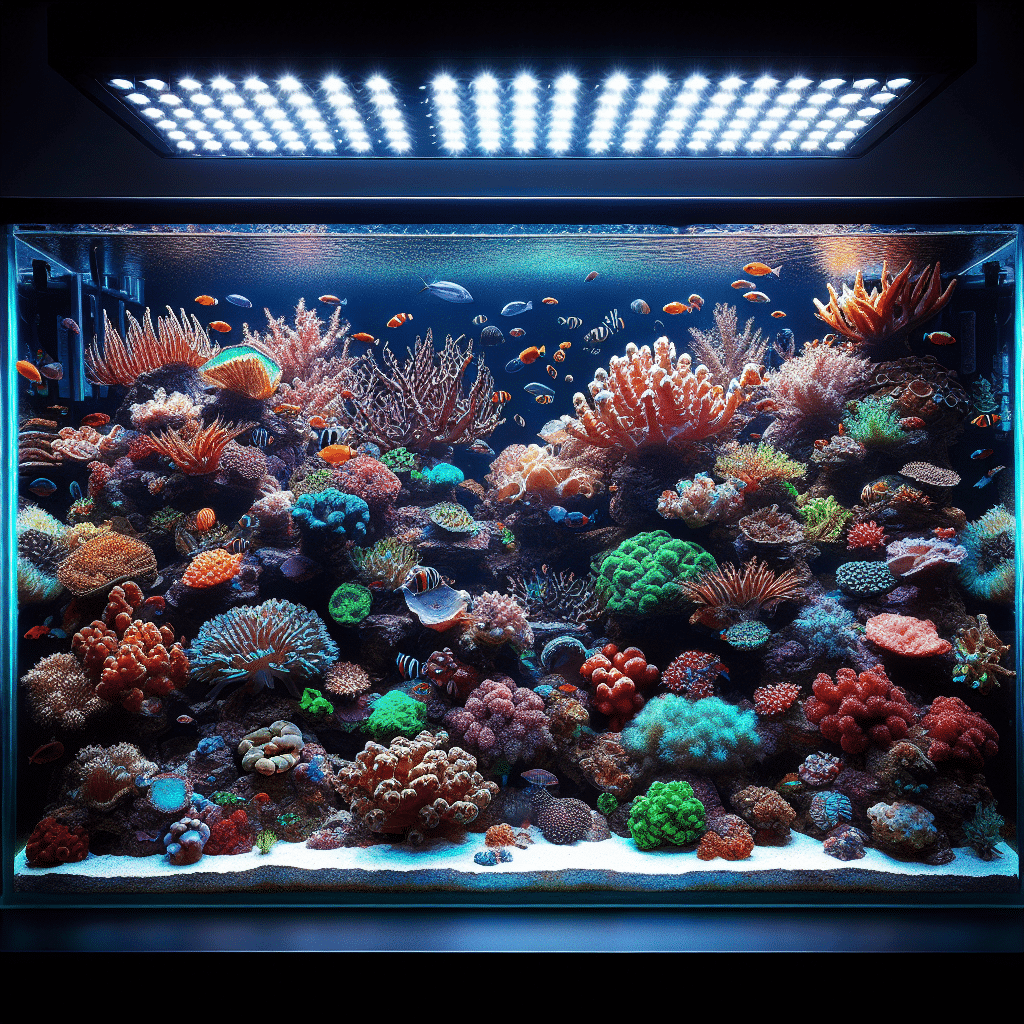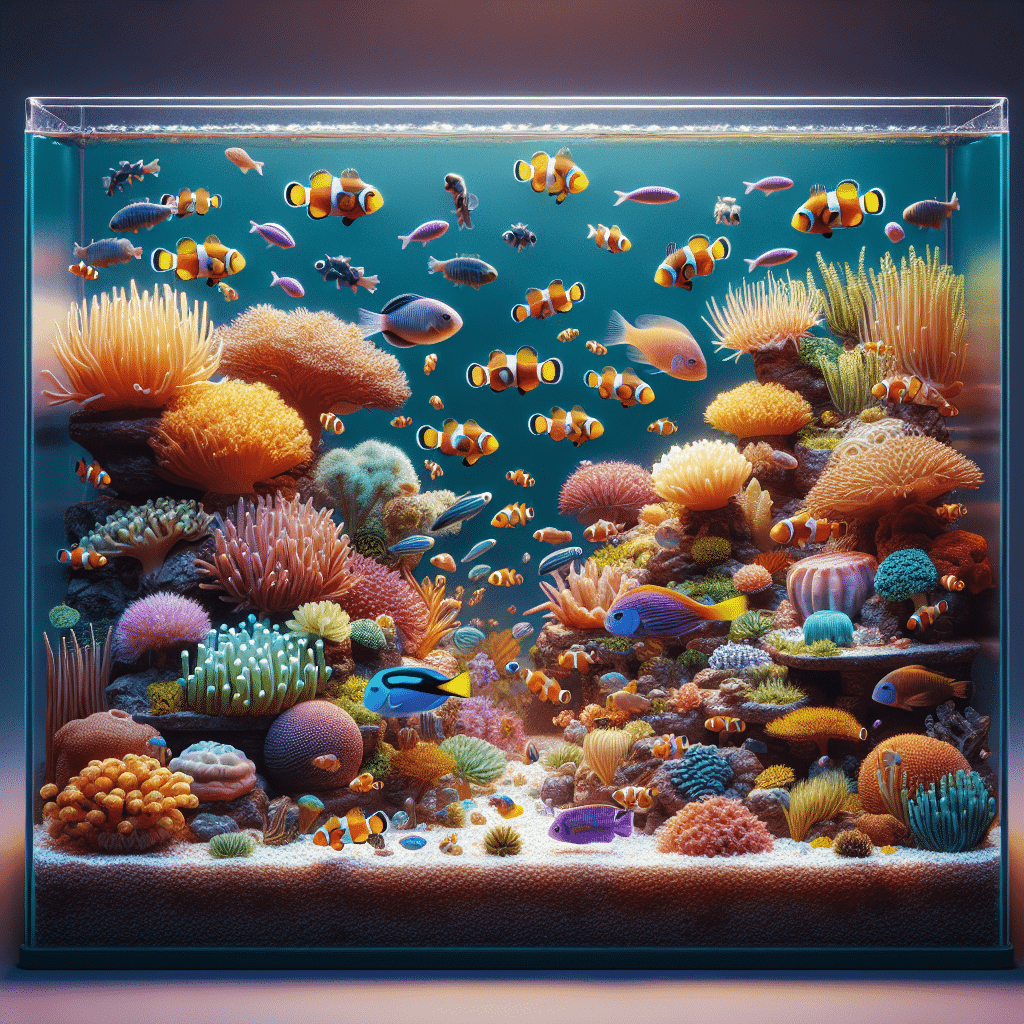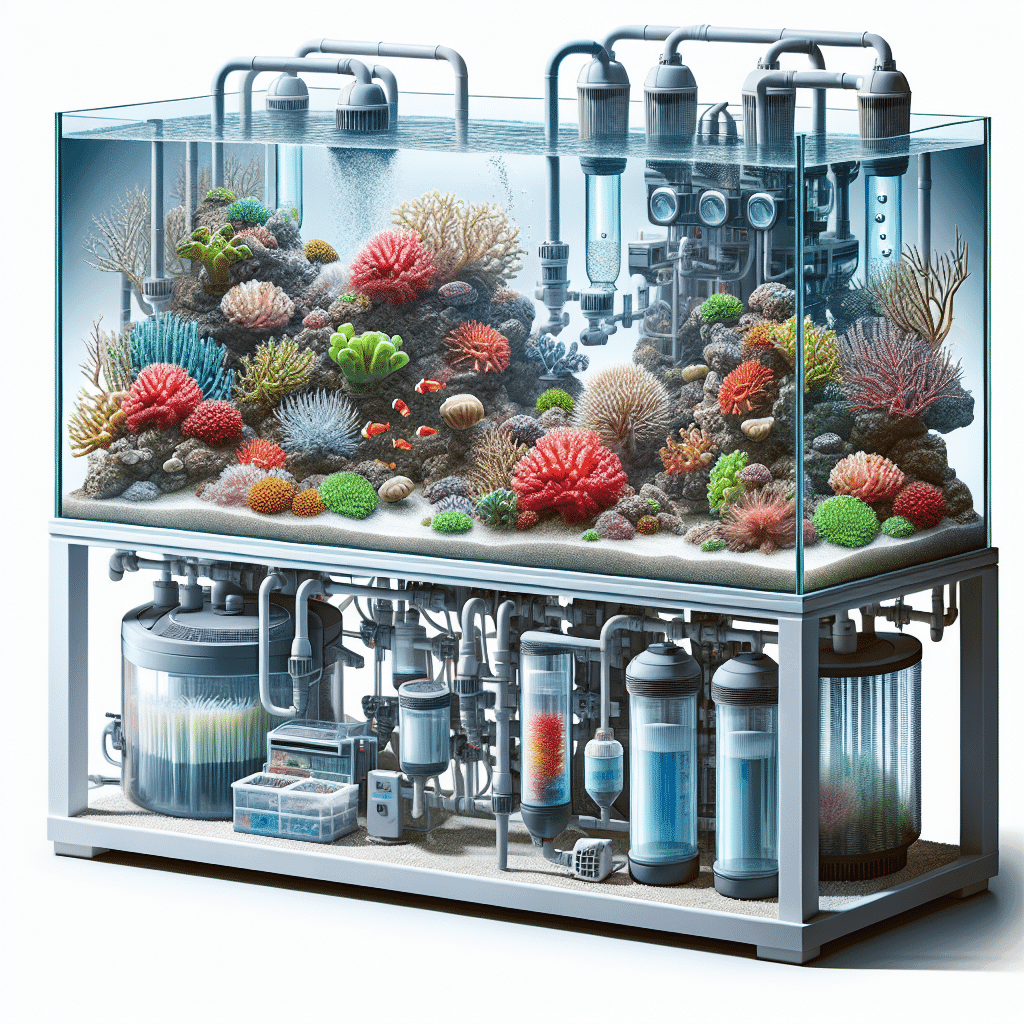Understanding Light in Reef Tanks
Lighting is a fundamental aspect of setting up a successful nano reef tank. The type and spectrum of light used can have a significant impact on the health and growth of corals and other marine life.
Impact of Light Spectrums on Corals
Different light spectrums impact corals in various ways. Blue light is essential for coral growth, while red light is crucial for photosynthesis and overall health. Additionally, green light can enhance coral coloration and fluorescence (Reef2Reef). Understanding how these spectrums interact with corals helps aquarists to create optimal lighting conditions.
| Light Spectrum | Importance |
|---|---|
| Blue Light | Promotes coral growth |
| Red Light | Essential for photosynthesis |
| Green Light | Enhances coloration and fluorescence |
For corals, the intensity of light reaching them depends on the depth at which they live. Factors such as water turbidity and suspended particles also affect light intensity. Adjusting light levels for corals from turbid environments may be necessary to ensure they thrive (TFH Magazine).
Importance of Light Spectrum for Coral Health
The color temperature of the lighting, measured in degrees Kelvin (K), is crucial for aquarium lighting. Marine aquarium lighting typically ranges from 6000K to 14000K, with higher color temperatures appearing bluer. This higher temperature mimics the natural conditions corals experience underwater (TFH Magazine).
Different corals require specific light spectrums to flourish, depending on their natural habitat. For instance, deep water corals benefit from blue and violet light, while shallow water corals thrive with red wavelengths. Matching the lighting needs of individual coral species is essential to avoid issues such as excessive light that can harm corals or insufficient light that can hinder photosynthesis (Top Shelf Aquatics).
Setting up a lighting schedule is also vital, with most tropical fish and marine species requiring about 12 hours of light and 12 hours of darkness daily. A timer can help maintain this cycle, ensuring a thriving environment for all the inhabitants of the nano reef tank (Top Shelf Aquatics).
By understanding the impact of light spectrums and their importance for coral health, individuals can make informed decisions about their nano reef tank setup and ensure a vibrant, healthy ecosystem.
Lighting Options for Nano Reef Tanks
Choosing the right lighting for a nano reef tank is crucial for the health and growth of corals and other marine life. Two prominent options in the market are LED lighting and T5 fluorescent lighting. Each has its unique benefits and characteristics that can influence a hobbyist’s decision.
LED Lighting Overview
LED lighting is the most popular choice among reef tank enthusiasts due to its efficiency and advanced control features. This lighting option provides superb light intensity without generating excessive heat, making it ideal for maintaining optimal tank conditions. LEDs are energy-efficient and available in multiple colors, which allows for customizing the light spectrum to suit specific coral needs.
| Feature | LED Lighting |
|---|---|
| Energy Efficiency | High |
| Heat Transfer | Minimal |
| Lifespan | Long (up to 50,000 hours) |
| Cost | Higher initial investment but cost-effective long-term |
| Control Features | Smart controls available |
Recommended brands include Ecotech Radion and AI Hydra 32HD, both known for their reliability and effectiveness in supporting coral health. While the upfront cost can be a consideration, the long-term savings and benefits make LED lighting a smart choice for 99.9% of reef tank owners (Bulk Reef Supply).
T5 Fluorescent Lighting Benefits
T5 fluorescent lighting is a viable alternative to LED systems, particularly beneficial for first-time tank owners. T5 fixtures provide the necessary spectrum and output for coral growth without requiring extensive settings or adjustments, simplifying the lighting process.
| Feature | T5 Fluorescent Lighting |
|---|---|
| Energy Efficiency | Moderate |
| Heat Transfer | Moderate |
| Lifespan | Shorter (about 10,000 hours) |
| Cost | Lower initial investment |
| Control Features | Limited |
T5 fixtures produce a diffused light output that can help cover larger areas of the tank evenly. This type of lighting is often less expensive upfront, making it attractive for beginners. However, users should be aware that T5 bulbs require periodic replacement, which can add to maintenance costs over time (Bulk Reef Supply).
Both LED and T5 fluorescent lighting systems have their advantages and disadvantages. The choice between them will depend on individual preferences, budget, and the specific needs of the corals and fish within the nano reef tank. For more information on setting up and maintaining your tank, explore our articles on nano reef tank setup and nano reef tank maintenance.
Light Spectrum and Coral Growth
Understanding the role of light spectrum is essential for ensuring healthy coral growth in a nano reef tank. Different wavelengths of light impact corals in various ways, with blue and red light being particularly significant.
Blue Light for Coral Growth
Blue light is vital for the growth of corals. This wavelength promotes photosynthesis by aiding in the absorption of energy needed for coral development. Many corals naturally thrive in environments rich in blue light, such as deeper waters, where this spectrum penetrates more effectively.
Research indicates that blue light enhances coral growth and resilience to stress, making it an essential component of any nano reef tank lighting. Here’s a summary of how blue light benefits coral growth:
| Benefit | Description |
|---|---|
| Promotes Photosynthesis | Blue light is absorbed efficiently by chlorophyll, facilitating energy production. |
| Enhances Growth Rates | Increased blue light results in quicker growth of corals. |
| Improves Resilience | Corals exposed to adequate blue light show better stress tolerance. |
It is important to match the intensity of blue light to the specific needs of the coral species in the aquarium. For more detailed insights into suitable coral options, visit our page on nano reef tank corals.
Red Light for Photosynthesis
Red light plays a crucial role in the photosynthesis process as well, supporting the overall health of corals. While blue light is primarily responsible for growth, red light complements this by enhancing the photosynthetic efficiency of corals, particularly in shallower environments where red wavelengths are more prevalent.
Different coral species require varying amounts of red light, depending on their natural habitats. For instance, shallow-water corals benefit significantly from exposure to red wavelengths. Here’s a brief overview of the importance of red light:
| Benefit | Description |
|---|---|
| Supports Photosynthesis | Red light aids in the conversion of light energy into chemical energy. |
| Enhances Coral Health | Sufficient red light can improve the overall vitality of corals. |
| Affects Coloration | Red light can influence coral coloration, enhancing visual appeal. |
Selecting the appropriate light spectrum is crucial for maintaining a thriving nano reef tank. Understanding the needs of individual coral species will help prevent issues related to excessive or insufficient lighting, which can hinder growth and health (Top Shelf Aquatics). For further information on creating the ideal setup, check our guide on nano reef tank setup.
Choosing the Right Lighting Setup
Selecting the appropriate lighting for a nano reef tank is essential for the health and growth of corals and other marine life. This section compares LED lighting and T5 fluorescent lighting, along with the factors that influence the choice of lighting setup.
LED vs. T5 Lighting
LED lighting has become the dominant choice in the market for reef tank lighting due to its efficiency and advanced control options. It is particularly beneficial for beginners, as it offers presets that simplify the setup process. LEDs are efficient in power consumption and do not transfer heat into the water, making them a smart choice for 99.9% of reef tank owners (Bulk Reef Supply).
On the other hand, T5 fluorescent lighting serves as a viable alternative, especially for first-time tank owners. T5 fixtures provide the necessary spectrum and light output for coral growth without requiring detailed spectrum settings or output tuning. This makes T5 lighting simpler to use (Bulk Reef Supply).
| Feature | LED Lighting | T5 Fluorescent Lighting |
|---|---|---|
| Efficiency | High | Moderate |
| Heat Transfer | Low | Moderate |
| Control Options | Advanced controls available | Limited controls |
| Setup Complexity | Requires some knowledge | Simple setup |
| Lifespan | Long-lasting | Moderate lifespan |
| Initial Cost | Higher upfront cost but lower operational costs | Lower upfront cost but higher operational costs |
Factors Influencing Lighting Choice
Several factors should be considered when choosing the right lighting setup for a nano reef tank:
Coral Types: Different corals have varying light requirements. Understanding the specific needs of the corals in the tank can guide the choice between LED and T5 lighting.
Tank Size: The size of the nano reef tank can influence lighting needs. Larger tanks may require more powerful lighting to ensure adequate coverage and penetration.
Budget: The initial cost of lighting fixtures and the ongoing operational costs can affect the decision. LEDs typically have a higher upfront cost but lower electricity bills.
Ease of Use: For beginners, simplicity can be crucial. T5 lighting might be preferable for those who want an uncomplicated setup without the need for adjusting settings.
Heat Management: Since LEDs produce less heat, they are often preferred in smaller tanks where temperature control is critical.
Understanding these factors helps in making an informed decision about the best lighting for a specific nano reef tank setup. For more information on setting up a nano reef tank, visit our articles on nano reef tank setup and nano reef tank equipment.
Best Practices for Nano Reef Tank Lighting
Proper lighting is essential for maintaining a healthy nano reef tank environment. Implementing a well-structured lighting schedule and controlling light intensity and spectrum are key components of effective nano reef tank lighting.
Setting up a Lighting Schedule
Establishing a regular lighting schedule is crucial to maintaining a day and night cycle for marine species in a reef aquarium. Most tropical fish and marine organisms require approximately 12 hours of light followed by 12 hours of darkness each day. Using a timer for reef aquarium lighting can help ensure this consistent cycle, allowing the aquarium to thrive.
| Time of Day | Lighting Duration |
|---|---|
| Daylight (Light ON) | 12 hours |
| Nighttime (Light OFF) | 12 hours |
This schedule mimics natural light patterns, supporting the health of fish and corals. Adjusting the photoperiod can also help simulate seasonal changes, promoting more natural behaviors and growth patterns in the inhabitants of the tank.
Controlling Light Intensity and Spectrum
Controlling both the intensity and spectrum of light is essential for optimizing coral health and growth in a nano reef setup. LED lights offer advanced control options, allowing users to adjust photoperiod, intensity, and spectrum to meet the specific needs of their reef inhabitants.
Intensity: The intensity of the light affects coral growth and the overall health of the tank. It is essential to research and find the right intensity level for the specific corals in the tank. Too much light can lead to bleaching, while too little can hinder growth.
Spectrum: Different coral species thrive under different light spectrums. Blue light is particularly important for coral growth, while red light plays a role in photosynthesis. Adjusting the spectrum according to the needs of the corals can significantly impact their health (Bulk Reef Supply).
By integrating timers and using LED lights with customizable features, aquarists can effectively manage both the intensity and spectrum of light in their nano reef tanks. This proactive approach not only enhances the aesthetic appeal of the aquarium but also promotes a vibrant and healthy ecosystem.
For more tips on setting up an optimal reef environment, consider reading about nano reef tank setup and nano reef tank maintenance.
Popular Nano Reef Tank Lighting Products
Choosing the right lighting for a nano reef tank is essential for the health of corals and overall tank aesthetics. Here are three popular lighting products that cater to the needs of nano reef enthusiasts.
AquaIllumination Prime 16 HD LED
The AquaIllumination Prime 16 HD LED is a versatile and efficient lighting option for nano reef tanks. It can effectively cover up to a 20″ square area, making it suitable for various tank sizes. This LED light consumes a maximum of 59 watts and is designed to support soft corals and LPS (Large Polyp Stony) corals.
Key features include:
- WiFi Capability: Users can control the lighting through the myAI app, allowing for easy adjustments to settings.
- Adjustable Spectrum: This light offers customizable spectrum options to meet the specific needs of different corals.
| Specification | Value |
|---|---|
| Coverage Area | 20″ square |
| Maximum Wattage | 59 watts |
| Coral Compatibility | Soft corals, LPS |
| Control Method | WiFi, myAI app |
EcoTech Marine Radion XR15 G6 LED
The EcoTech Marine Radion XR15 G6 LED is one of the most powerful options available. It pulls a maximum of 100 watts and is capable of providing average PAR (Photosynthetically Active Radiation) levels suitable for SPS (Small Polyp Stony) corals over a 24″ square area.
Key features include:
- HEI2 Optics: This ensures an even spread of light across the tank.
- Mobius-Ready: The light can be controlled via smartphone for added convenience.
| Specification | Value |
|---|---|
| Coverage Area | 24″ square |
| Maximum Wattage | 100 watts |
| Coral Compatibility | SPS corals |
| Control Method | Smartphone (Mobius) |
Reef Breeders Reef Nano LED
The Reef Breeders Reef Nano LED is a budget-friendly option priced under $160. This pendant-style LED light pushes a maximum of 30 watts and is suitable for tanks up to 20″ wide, providing adequate output for soft corals and LPS.
Key features include:
- Onboard Digital Controller: This allows users to set up time schedules and make spectrum adjustments, although it lacks wireless control.
| Specification | Value |
|---|---|
| Coverage Area | 20″ wide |
| Maximum Wattage | 30 watts |
| Coral Compatibility | Soft corals, LPS |
| Control Method | Onboard controller |
These lighting products are among the best options available for enhancing the growth and health of corals in a nano reef tank. Proper lighting setup is crucial for maintaining a thriving aquatic environment. For more information on setting up a nano reef tank, check out our article on nano reef tank setup.



